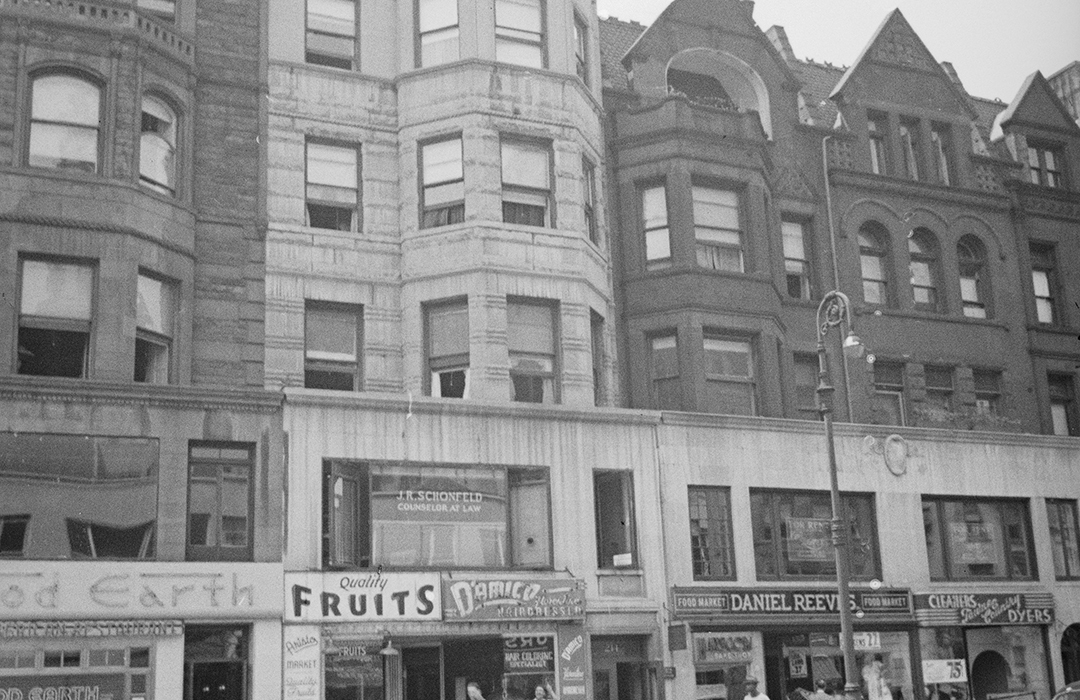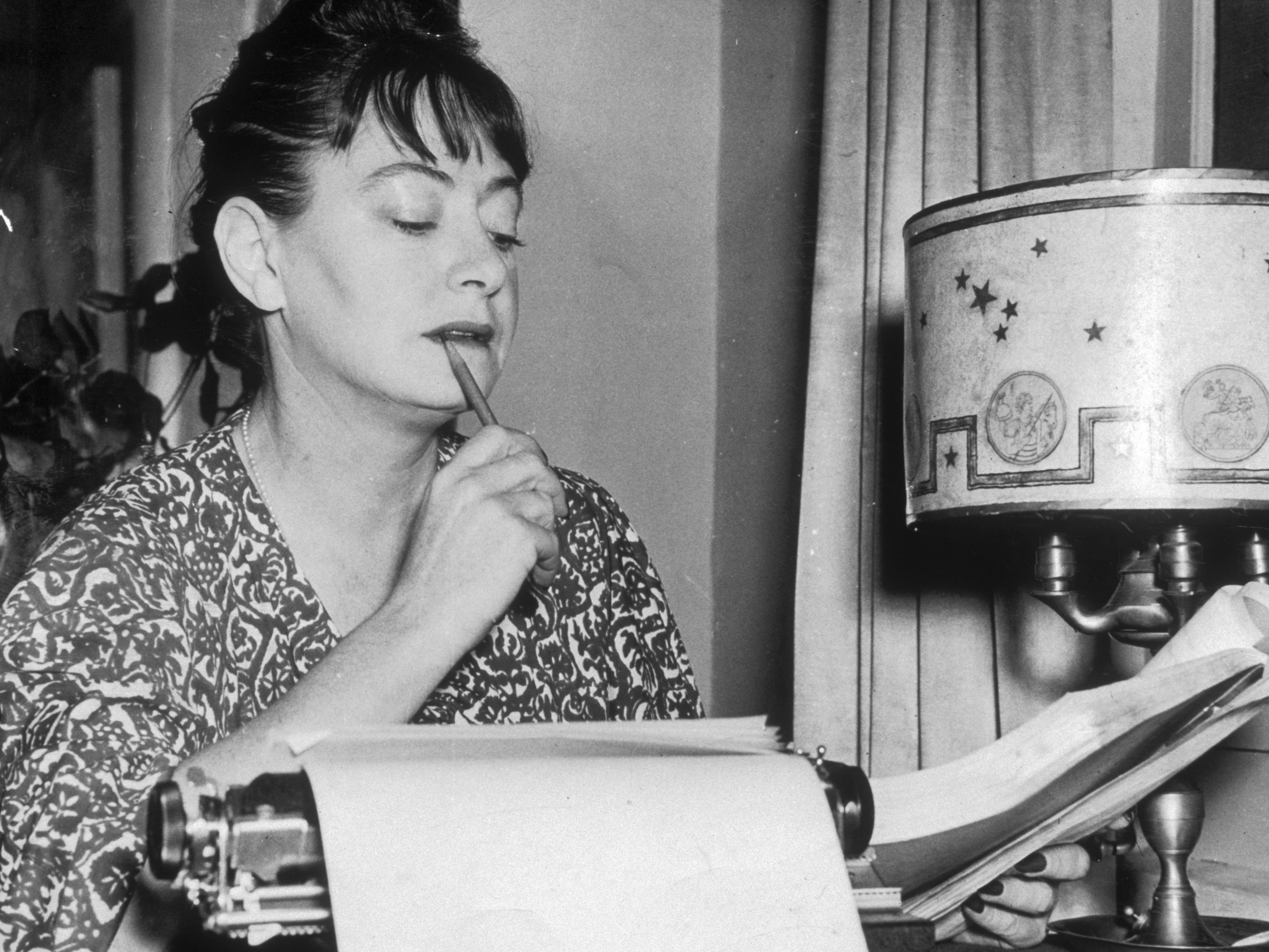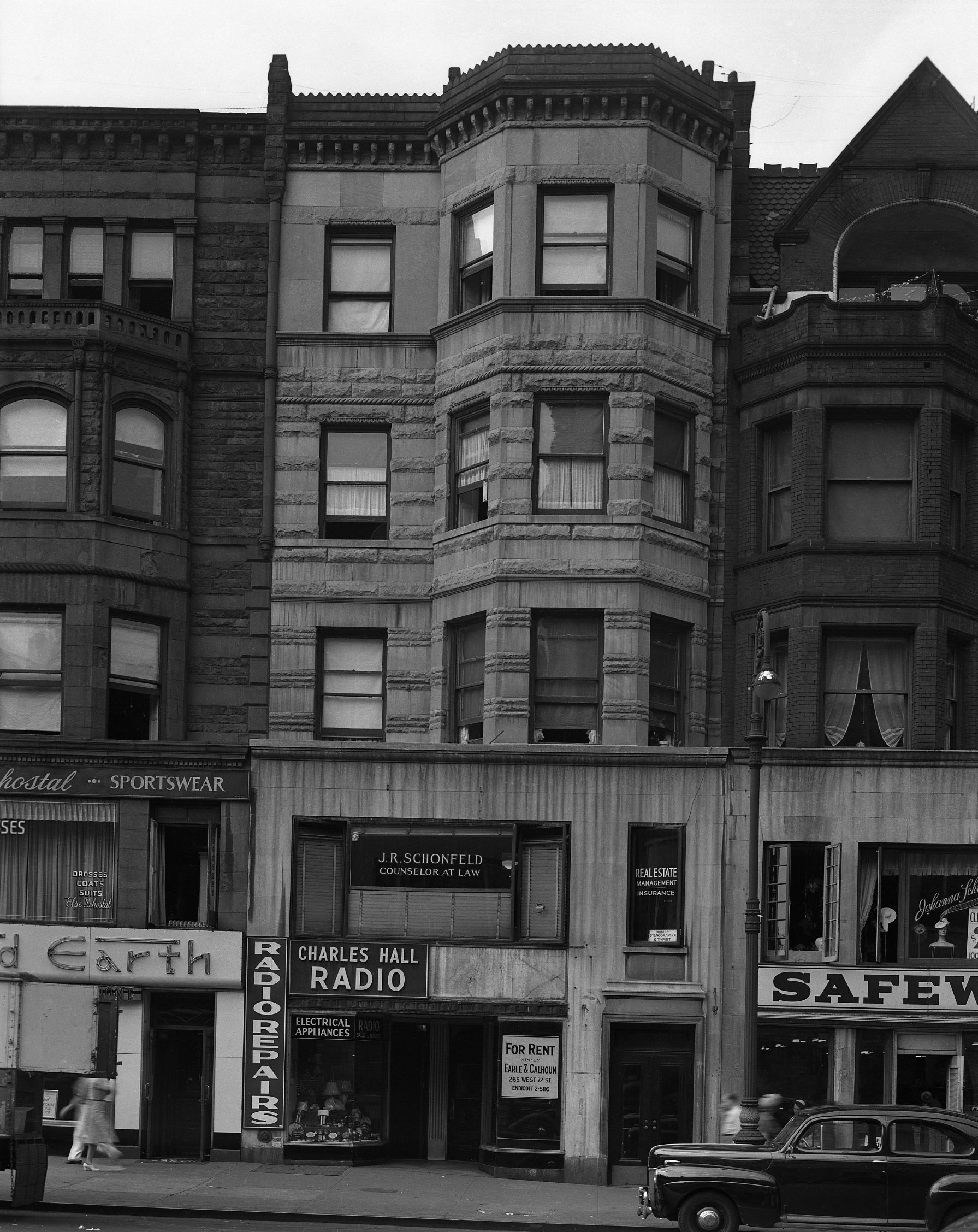
Dorothy Parker’s Childhood Home
by Tom Miller
In 1888, the Parks Commissioners voted to improve West 72nd Street “with macadamized pavement.” Considering the upscale tone of the street, with already more than 60 fine homes and the luxurious Dakota Apartments, the Commissioners agreed to broaden the sidewalks by seven feet, to accommodate the planting of trees and grass.
Joining in on the development of the posh residential street two years later was developer William Miller, who commissioned William H. Boylan to design four townhouses at Nos. 208 through 214, between Broadway and West End Avenue.
Completed in 1892, they were designed in the popular Queen Anne style. Four stories tall above English basements, they were faced in limestone and trimmed in contrasting brownstone. Sharply angled bays, rusticated banding, limestone bracketed cornices and a profusion of stained glass put them on the cutting edge of stylish domestic architecture.
Real estate operator William H. Gray purchased 212 and 214 West 72nd Street, hoping no doubt to make a quick profit. On April 15, 1893 he advertised both houses, describing them as “four-story brown and whitestone houses, with butler’s pantry extensions, on full lots, and are finished with all the improvements known to the builder’s art.”
Unfortunately, Gray would not live to see 214 sold. Just over six months later, on November 2, The New York Times reported that J. H. Rothschild had purchased the 25-foot wide house from Gray’s estate. The $60,000 Rothschild paid would be more than $1.6 million today.
Jacob Henry Rothschild had come a long away. His parents arrived among the large German-Jewish immigration of the 1840s. Unlike so many Jewish immigrants who clustered in Manhattan’s Lower East Side, they went to Selma, Alabama, where Jacob was born in 1851.
In 1860 the family moved to New York City where Samson Rothschild opened a “gents furnishings” store on Broadway. Doing well, he leased half of a two-family residence on West 27th Street in 1861. The other half was taken by the Thomas Marston family. Among the Marston’s three children was daughter Eliza Annie, one year older than Henry (by now he preferred to use his middle name more often than his first).
Despite both sets of parents disapproving of their romance, the stalwart lovers finally married in 1880; 12 years after they first met. By the time Rothschild purchased the West 72nd Street house he was a highly successful businessman, a member of the cloak manufacturing firm of Meyer, Jonasson & Co.
Rothschild’s substantial income enabled the family to take a cottage every summer in West End, New Jersey, near the fashionable seaside resort of Long Branch. In the summer of 1893 Eliza was pregnant (quite possibly an unplanned circumstance given that the couple’s three children were twelve, nine and six years old). The baby, named Dorothy, was prematurely born in the summer cottage on August 22.
Three months later the Rothschilds were moving their things into number 214 West 72nd Street. Merchant class wealth provide the family with a staff of Irish servants and proper schools for the children.
Little Dorothy was four years old when her life was unexpectedly thrown into shambles. On July 20, 1898, Eliza died in their cottage at West End, New Jersey. Just four months later, on November 28, her father sold the 72nd Street house to Thomas Henry Wheeler.
Yet money rarely bought acceptance for Jewish families into mainstream society. With little hope of membership into exclusive social clubs, wealthy Jews had established the Progress Club. Henry was a member of both that club and the more inclusive Criterion Club. In both, members wore “club clothes,” or evening clothes, and talked business and sports in the cigar smoke filled rooms.
In the spring of 1895 Police Inspector William W. McLaughlin suffered humiliation when he was arrested and charged with extortion. He was accused of squeezing Francis J. Seagrist, Jr. for $50 years earlier while he was captain of the First Precinct.
As his trial neared in May, a friend, Leo Schlesinger, posted McLaughlin’s $25,000 bond; but then he withdrew it. The Evening World explained, “It is understood that Mr. Schlesinger’s reason for withdrawing from the bond is that he is to be a witness for McLaughlin.” He wanted to avoid the appearance of being a biased witness.
Henry Rothschild stepped in to free the disgraced officer. His faith in McLaughlin’s innocence led him to risk losing his relatively new home. On June 1, 1895 The Evening World reported “He offered as surety the four-story dwelling-house at 214 West Seventy-second street in which he lives.” The New York Times added that he had $40,000 equity in the property.
Although it took two years and multiple trials, the charges against McLaughlin were dismissed in April 1897 and the Rothschilds’ home was secure.
In the meantime, although little was heard about Eliza, Henry was visible in Jewish and business activities. He was on the Reception Committee of the Purim Ball in the Metropolitan Opera House on January 19, 1897, for instance. Other moneyed committee members included Isidore Straus, James Seligman and Adolph Lewisohn.
He was a member of the Businessmen’s Republican and Sound Money Association, which staged a dramatic demonstration in 1897 in the form of the Sound Money Parade. Rothschild was a marshal, and the official handbook called him “one of the best known manufacturers of cloaks in New York.”
Little Dorothy was four years old when her life was unexpectedly thrown into shambles. On July 20, 1898, Eliza died in their cottage at West End, New Jersey. Just four months later, on November 28, her father sold the 72nd Street house to Thomas Henry Wheeler.
And then, on January 3, 1900 he married Eleanor F. Lewis, described by School magazine as “the former accomplished principal of the Primary department in [Public School] No. 96.” Dorothy’s tranquil existence simmered into one of bitterness. According to Joan Acocella in her 2008 book 28 Artists & 2 Saints, Eleanor was a “hated stepmother” and “In later years, [Dorothy] rarely spoke of her father without scorn.”
Dorothy married Wall Street broker Edwin Pond Parker II in 1917. Despite her unhappy formative years, or perhaps because of them, she went on to become one of America’s best known writers and critics, and a founding member of the famous Algonquin Round Table literary group.
In the meantime, Thomas Henry Wheeler had paid Rothschild $62,500 for the house—a mere $2,500 more than Rothschild had originally paid. Wheeler was a vice-president with the Standard Oil Company, having been one of the firm’s founders. He had married Celia Roberts, “an accomplished musician, excelling as an organist,” as described by The New York Herald, in 1872.
Like several other Standard Oil executives, Wheeler had relocated his family from Ohio. The couple had four children, daughters Leita, Stella and Mary Louise; and son Ernest.
Celia slipped into Manhattan society, involving herself in charitable works like the Jennie Clarkson Home for Destitute Children. When a benefit concert was held in the Waldorf-Astoria in January 1905, Celia’s name appeared on the list of patronesses along with socialites like Mrs. John D. Rockefeller, Helen Miller Gould and Mrs. Harry J. Luce.
On April 25, 1905, Leita married Lieutenant Charles Preston Nelson of the United States Navy in the Marble Collegiate Church. It was an impressive ceremony, with the ushers in naval dress uniforms. Following the wedding, a reception was held in the 72nd Street house.
Nelson had graduated from Annapolis in 1898. He was already recognized for his roles in the Spanish-American and Philippine-American Wars. But his action during World War I would make him a darling of the press. Commanding a fleet of submarine chasers, he earned the nickname “Daredevil Nelson” and eventually rose to the rank of Rear Admiral.
But before any of that happened, it would be Mary Louise’s turn to marry. In April 1908, she became Mrs. William Thompson Dewart in the same church where Leita had been wed. The New York Times description of the bride hinted at the family’s upscale lifestyle. “Miss Wheeler is a musician, an equestrienne and an accomplished linguist.” Once again, a reception was held in the Wheeler townhouse.
Dewart was vice president of the Frank A. Munsey Company, publishers of periodicals like Munsey’s Magazine, and nearly a score of newspapers, including the New York Daily News, the Washington Times and The Boston Journal. He was, as well, president of the Mohican Company, a department store firm formed with his boss Frank A. Munsey.
Thomas H. Wheeler owned the luxurious yacht, the Empress, and the family maintained a “villa” named War-Winett, on Win-Net Island in the fashionable Thousand Islands district. Their names appeared in society columns routinely for their entertaining bout upon the yacht and in the summer home.
On December 15, 1919 Leita may have shocked society when she divorced her well-known husband. Two months later, on February 25, she and Henry George Pearce, a Philadelphia steel executive, obtained a marriage license.
The couple was married in the apartment of Mary Louise and William Dewart in the Apthorp Apartments. The Times noted that the “wedding was a very small one, the bride’s only child, Miss Leita Nelson, aged 13, being one of the guests.” Like the other newspapers reporting on the wedding, The Times could not help adding “her first husband, Captain Charles Preston Nelson, commander of submarine chasers in the United States Navy, [is] known as ‘Daredevil’ Nelson.”
Number 214 West 72nd Street was the scene of an elaborate dinner and reception on May 21, 1922 in celebration of the Wheelers’ golden wedding anniversary. The New York Herald remarked that “Some of those present had crossed the continent for the occasion, others coming from distant cities.”
An orchestra played during dinner, “which was served at small tables,” according to the article. The wealthy guests had, of course, provided expensive tributes; and The Herald mentioned one in particular. “Many gifts had been sent by relatives and friends, including a table service of gold and other ornaments.”
Nelson had graduated from Annapolis in 1898. He was already recognized for his roles in the Spanish-American and Philippine-American Wars. But his action during World War I would make him a darling of the press. Commanding a fleet of submarine chasers, he earned the nickname “Daredevil Nelson” and eventually rose to the rank of Rear Admiral.
Among those in the house that night was the Wheelers’ granddaughter, Leita Nelson, now 16-years old. Two months later, she and her mother were staying with the Wheelers at War-Winett. Also at Thousand Islands that summer was the May family, described by The Times as “socially prominent in Philadelphia.” The Mays, who had a 20-year old son, William and the Pearces were good friends. The close relationship led to a romance between Leita and William; one, which both families objected to “because of the youth of Miss Nelson and William.”
On the night of July 25, everyone attended a dance at the Thousand Island Club. When it ended, Leita could not find her daughter. It was soon evident that William May was also missing. Leita called John M. Gibbons, attorney for the New York, New Haven & Hartford Railroad, who went to the garage where the May family’s vehicles were kept and found William’s speedster was gone.
Major Daniel Chandler, a friend of the Wheelers and an organizer of the New York State Police, was notified. While troopers watched the roadways for the car, the Canadian Pacific Railroad was called. Gibbons had heard at the garage that the runaways had asked directions to Montreal.
Just before dawn the following morning, the roadster was spotted just outside of Montreal. Leita, Mary Louise, and a friend, Mrs. J. Christie headed off to Montreal to “have a talk” with the young Leita. Once again, in reporting on the elaborate process that led to upsetting the elopement, newspapers brought up the colorful and heroic Nelson. “Her father [is] Captain Juggie Nelson, U. S. N. who was decorated by Italy, France and England during the war,” noted The Times.
By the time Thomas Henry Wheeler died in 1926, West 72nd Street, once among the most exclusive Upper West Side thoroughfares, had been heavily changed by commerce. Two years later 214 was converted to a store at ground level, offices on the second floor, and eight “non-housekeeping apartments” (meaning they had no kitchens), on each floor above. Only the three upper floors of the façade were left relatively untouched.
The address, once home to two wealthy families and their staffs of servants, would never again appear in society columns. It would have one more recognized resident however. Gerard Alphenaar had been organist in St. Bavo Cathedral in Haarlem in his native Holland and a guest conductor of European orchestras. He and his wife Beatrice, immigrated to New York City in the 1930s.
In 1940, he became organist at the West End Collegiate Church. Four years later, he became director of the concert department at the Edward B. Marks Music Corporation on West 52nd Street as well. By the early 1960s, the couple was living at 214 West 72nd Street.
On Sunday, February 7, 1965, Apphenaar had just completed playing a service in a Bronx church when he suffered a fatal heart attack at the age of 65.
Today the Rothschild house, where one of America’s best known writers and brilliant wits sent her early years, has a nail salon and a massage studio in the lower two floors. The end of the road for the only surviving house of Boylan’s 1892 row, however was nearing. In December 2017 plans were filed for a 21-story mixed use building proposed to rise 219 feet above Broadway and 72nd Street. In a nod to Dorothy Parker, the developer plans to name the building Parker West.
Tom Miller is a social historian and blogger at daytoninmanhattan.blogspot.com
LEARN MORE ABOUT




